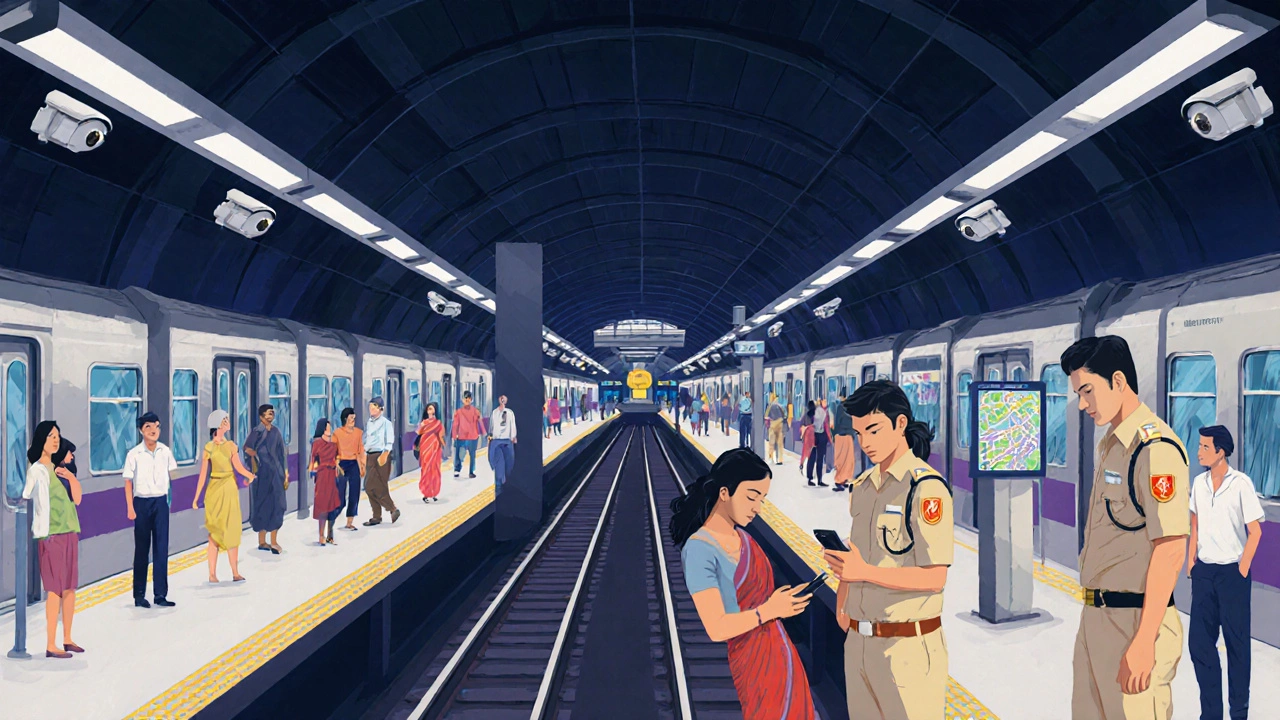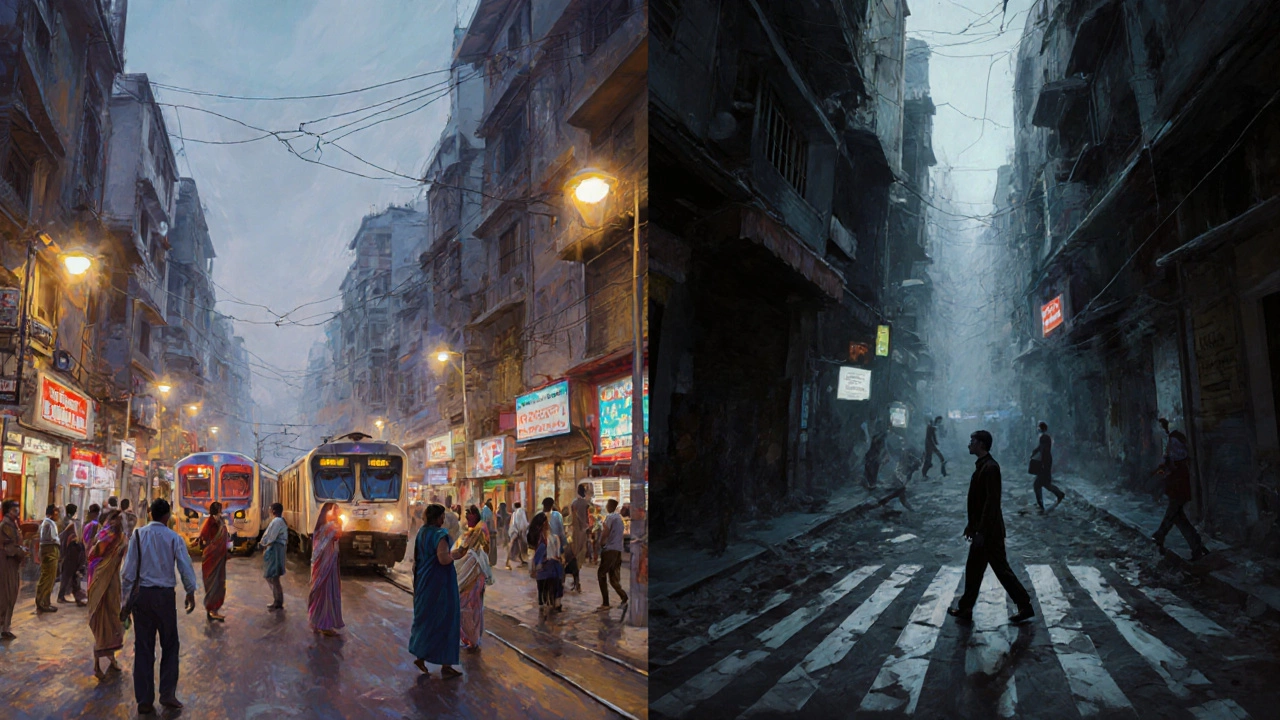When you’re planning a trip to India, one of the first questions that pops up isn’t about temples or food-it’s safety. Specifically: Mumbai or Delhi? Which one feels more secure for a solo traveler, a family, or someone visiting for the first time?
The truth isn’t in headlines. It’s in the daily rhythm of the streets, the way locals behave, the lighting on side alleys, and how quickly help arrives when you need it. Both cities are huge, complex, and full of life. But they’re not the same when it comes to safety.
Mumbai: The City That Doesn’t Sleep, But Watches Out
Mumbai doesn’t scare you with noise. It scares you with silence-the kind that follows a sudden shove in a crowded train, or the way a streetlight flickers out near a railway bridge after 11 p.m. But here’s what you won’t hear from most locals: Mumbai is actually one of the safest major cities in India for women traveling alone.
In 2024, the National Crime Records Bureau showed Mumbai had the lowest rate of violent crimes per capita among India’s top five cities. Pickpocketing happens, especially at Chhatrapati Shivaji Terminus or on local trains during rush hour. But physical assaults? Rare. The city runs on a kind of unspoken social code. If you look lost, someone will ask if you need help. If you’re harassed on the street, bystanders often step in.
Public transport is your best friend here. The suburban rail network carries over 7 million people daily. It’s packed, yes-but it’s also monitored. Women-only compartments are strictly enforced. CCTV cameras line every station. And unlike Delhi, there’s no culture of aggressive honking or reckless driving. Traffic moves in lanes. Pedestrians have zebra crossings that are mostly respected.
At night, areas like Bandra, Juhu, and Colaba stay lively. Restaurants stay open until 2 a.m. Taxis and app-based rides like Ola and Uber are widely available and tracked. You can walk from a café to your hotel in South Mumbai after dinner without feeling like you’re risking your life.
Delhi: The City That Demands Awareness
Delhi is different. It’s louder. It’s more chaotic. And statistically, it’s more dangerous.
In 2023, Delhi reported over 5,000 cases of crimes against women-more than Mumbai, Bengaluru, and Hyderabad combined. That includes harassment, stalking, and assault. It’s not that Delhi is full of monsters. It’s that the systems don’t always catch them. Street lighting is patchy in older neighborhoods like Chandni Chowk after dark. Police presence is visible near tourist spots like India Gate or Humayun’s Tomb-but vanish a few blocks away.
Women traveling alone are advised to avoid public transport after 8 p.m. Auto-rickshaws without meters are a risk. Even app-based cabs can be unreliable if you’re in a remote area. There are stories of drivers taking detours, especially near the airport or in South Delhi’s gated colonies.
But here’s the twist: Delhi is also where you’ll find the most helpful locals. In Old Delhi, shopkeepers will call you over to warn you about a sketchy alley. In Connaught Place, security guards at malls will walk you to your car. The city has a thick layer of community vigilance-you just have to know where to look for it.
Delhi’s metro is clean, efficient, and safe. It’s the one place where you can move freely after dark. Stations are well-lit, staffed, and monitored. If you stick to the metro and pre-booked rides, you’re fine. But if you wander into areas like Loni, Najafgarh, or even parts of East Delhi after sunset, you’re entering a different world-one where safety isn’t guaranteed.
What the Numbers Don’t Tell You
Crime statistics can be misleading. Mumbai’s lower numbers don’t mean it’s perfect. Petty theft is common. Tourists get targeted at Gateway of India for fake tour guides. At Dharavi, unlicensed guides sometimes lead visitors into unsafe zones. But the city responds fast. Police stations are never more than 2 km apart. You can report a stolen phone and get a case number within 20 minutes.
Delhi’s higher numbers come from a mix of factors: population density, migration from rural areas, and under-resourced local policing. The city has over 30 police stations, but many are understaffed. If you’re robbed in a quiet lane near Mehrauli, you might wait an hour for someone to show up.
But here’s something no report mentions: Delhi has more female police officers on patrol than any other Indian city. And they’re visible. In places like Hauz Khas or Saket, you’ll see women officers walking in pairs, checking alleyways. They don’t always stop you-but they’re there.

Where to Stay: Safety by Neighborhood
Where you stay matters more than which city you pick.
In Mumbai, stick to South Mumbai: Colaba, Fort, Marine Drive, and Bandra. These areas are walkable, lit, and full of security cameras. Avoid the outskirts like Thane or Navi Mumbai unless you have a trusted local connection.
In Delhi, go for Central Delhi: Connaught Place, Khan Market, and Lutyens’ Delhi. These are the safest zones. Avoid places like Jahangirpuri, Bhalswa, or areas near the Delhi-Haryana border. Even tourist-heavy areas like Chandni Chowk are safe during the day-but not alone at night.
Hotels in both cities have improved. Most now offer 24-hour security, in-room safes, and staff who can call a cab for you. But don’t assume. Always ask: "Is there a guard at the back entrance?" and "Can I get a ride back at midnight?"
How to Stay Safe: Real Tips That Work
Here’s what actually helps, not just what you read online:
- Download the SafeCity app-it’s free, works offline, and lets you send your location to a trusted contact with one tap.
- Carry a power bank. Dead phones = lost help.
- Learn three Hindi phrases: "Mujhe madad chahiye" (I need help), "Police kahan hai?" (Where is the police?), and "Yeh jagah safe hai?" (Is this place safe?).
- Don’t wear expensive jewelry. It doesn’t make you look rich-it makes you look like a target.
- Use only registered taxis or app-based rides. Never flag down random autos.
- Keep a photocopy of your passport and visa in your bag. Leave the original in the hotel safe.
And here’s the biggest one: trust your gut. If a street feels off, leave. If someone insists you go with them "just a little way," say no. You’re not rude-you’re smart.

Final Verdict: Which City Is Safer?
Mumbai is safer for first-time travelers. It’s more predictable. The rules are clearer. The infrastructure supports you. The people are used to tourists. If you’re traveling solo, with kids, or just want to relax without constant vigilance, Mumbai wins.
Delhi is safer if you know how to navigate it. If you’ve been to India before, if you’re comfortable with chaos, and if you stick to the right areas, Delhi is worth it. The history, the food, the markets-it’s unmatched. But you need to be alert. You need to plan. You need to avoid the temptation to "just walk around."
Neither city is dangerous if you’re prepared. But one gives you more room for error. That’s Mumbai.
What to Do Next
If you’re choosing between the two, ask yourself:
- Do I want to explore ancient history and bustling markets? → Delhi.
- Do I want to eat seafood, walk by the sea, and feel like I can wander without worry? → Mumbai.
- Am I traveling alone? → Mumbai.
- Am I traveling with a group and know how to stay cautious? → Delhi is fine.
Book your flights. Pick your neighborhood. Download the app. And remember-safety isn’t about the city. It’s about your choices.
Is Mumbai safer than Delhi for solo female travelers?
Yes, generally. Mumbai has lower rates of violent crime and better street lighting, public transport safety, and bystander intervention. Women traveling alone can move around South Mumbai-even at night-with far less risk than in most parts of Delhi. The city’s culture of informal surveillance makes it more forgiving for newcomers.
Can I walk around Delhi at night?
Only in specific, well-known areas like Connaught Place, Khan Market, or Lutyens’ Delhi. Avoid walking anywhere else after dark, including near tourist sites like Humayun’s Tomb or India Gate after 9 p.m. Stick to app-based rides or the metro, which runs until midnight. If you must walk, go with a group and stay on main roads.
Is public transport safe in Mumbai?
Yes, especially the suburban trains and metro. Mumbai’s trains have women-only compartments, CCTV, and frequent patrols. The metro is clean, well-lit, and secure. Just avoid the last few cars on local trains during rush hour. Always use the front or middle compartments. App-based cabs like Ola and Uber are also reliable and tracked.
Which city has better medical facilities for tourists?
Both cities have top-tier hospitals. In Mumbai, Apollo Spectra and Jaslok Hospital are popular with tourists. In Delhi, Fortis and Max Super Speciality are well-equipped and English-speaking. Both cities have international clinics in upscale areas. Always carry travel insurance and know the nearest hospital before you go out.
Should I avoid certain areas in either city?
In Mumbai, avoid Dharavi after dark unless with a trusted guide. In Delhi, avoid Jahangirpuri, Bhalswa, Najafgarh, and areas near the Delhi-Haryana border. Even popular spots like Chandni Chowk can get crowded and chaotic-stick to main alleys and leave before sunset if you’re alone. Always check local advice before heading to unfamiliar neighborhoods.
Do I need to dress differently in Delhi vs. Mumbai?
Not necessarily. Both cities are modern and tolerant. But in Delhi, especially in Old Delhi or religious sites, covering your shoulders and knees is respectful-and helps avoid unwanted attention. In Mumbai, you can wear shorts or tank tops on the beach or in South Mumbai without issue. Dress for comfort, not fear. Confidence matters more than clothing.
Next Steps for Your Trip
Before you book anything, make a list: Where will you sleep? How will you get around? What’s your backup plan if you feel unsafe? Write it down. Share it with someone at home.
Download the SafeCity app. Save the number of your hotel’s front desk. Keep a local SIM card ready. And don’t forget-you’re not here to be perfect. You’re here to experience. The safest thing you can do is stay aware, stay calm, and trust your instincts. Both cities will welcome you. You just need to know how to walk through them.
